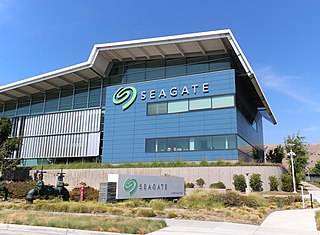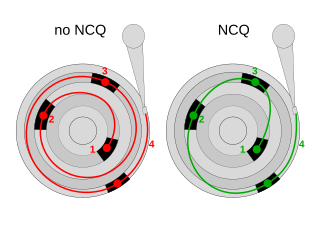
A hard disk drive (HDD), hard disk, hard drive, or fixed disk, is an electro-mechanical data storage device that stores and retrieves digital data using magnetic storage with one or more rigid rapidly rotating platters coated with magnetic material. The platters are paired with magnetic heads, usually arranged on a moving actuator arm, which read and write data to the platter surfaces. Data is accessed in a random-access manner, meaning that individual blocks of data can be stored and retrieved in any order. HDDs are a type of non-volatile storage, retaining stored data when powered off. Modern HDDs are typically in the form of a small rectangular box.

SATA is a computer bus interface that connects host bus adapters to mass storage devices such as hard disk drives, optical drives, and solid-state drives. Serial ATA succeeded the earlier Parallel ATA (PATA) standard to become the predominant interface for storage devices.

Seagate Technology Holdings plc is an American data storage company. It was incorporated in 1978 as Shugart Technology and commenced business in 1979. Since 2010, the company has been incorporated in Dublin, Ireland, with operational headquarters in Fremont, California, United States.

In computing, Native Command Queuing (NCQ) is an extension of the Serial ATA protocol allowing hard disk drives to internally optimize the order in which received read and write commands are executed. This can reduce the amount of unnecessary drive head movement, resulting in increased performance for workloads where multiple simultaneous read/write requests are outstanding, most often occurring in server-type applications.
Input/output operations per second is an input/output performance measurement used to characterize computer storage devices like hard disk drives (HDD), solid state drives (SSD), and storage area networks (SAN). Like benchmarks, IOPS numbers published by storage device manufacturers do not directly relate to real-world application performance.
In computing, a hybrid drive is a logical or physical storage device that combines a faster storage medium such as solid-state drive (SSD) with a higher-capacity hard disk drive (HDD). The intent is adding some of the speed of SSDs to the cost-effective storage capacity of traditional HDDs. The purpose of the SSD in a hybrid drive is to act as a cache for the data stored on the HDD, improving the overall performance by keeping copies of the most frequently used data on the faster SSD drive.
OCZ was a brand of Toshiba that was used for some of its solid-state drives (SSDs) before they were rebranded with Toshiba. OCZ Storage Solutions was a manufacturer of SSDs based in San Jose, California, USA and was the new company formed after the sale of OCZ Technology Group's SSD assets to Toshiba Corporation. Since entering the memory market as OCZ Technology in 2002, the company has targeted its products primarily at the computer hardware enthusiast market, producing performance DDR RAM, video cards, USB drives, power supplies, and various cooling products. SSD devices with the OCZ brand that are using SATA III, PCI Express, Serial attached SCSI and USB 3.0 interfaces, for both client and enterprise applications are currently being produced. OCZ Storage Solutions was dissolved on April 1, 2016 and absorbed into Toshiba America Electronic Components, Inc, which later then became Kioxia.

A solid-state drive (SSD) is a solid-state storage device. It provides persistent data storage using no moving parts.

Phison Electronics Corporation is a Taiwanese public electronics company that primarily designs, manufactures and sells controllers for NAND flash memory chips. These are integrated into flash-based products such as USB flash drives, memory cards, and solid-state drives (SSDs).

JMicron Technology Corporation is a Taiwan based fabless technology design house based in Hsinchu, Taiwan. As a manufacturer of integrated circuits, they produce controller chips for bridge devices.
Indilinx, Inc. was a formerly South Korean-based solid-state drive (SSD) controller manufacturer with business headquarters in San Jose, California. It was a wholly owned subsidiary of the OCZ Technology Group until the latter sold the former's assets to Toshiba in OCZ's bankruptcy sale, and those assets were fully integrated into the newly founded OCZ Storage Solutions division of Toshiba.
The Opal Storage Specification is a set of specifications for features of data storage devices that enhance their security. For example, it defines a way of encrypting the stored data so that an unauthorized person who gains possession of the device cannot see the data. That is, it is a specification for self-encrypting drives (SED).
A hybrid array is a form of hierarchical storage management that combines hard disk drives (HDDs) with solid-state drives (SSDs) for I/O speed improvements.

Write amplification (WA) is an undesirable phenomenon associated with flash memory and solid-state drives (SSDs) where the actual amount of information physically written to the storage media is a multiple of the logical amount intended to be written.

LSI Logic Corporation, was an American company founded in Santa Clara, California, was a pioneer in the ASIC and EDA industries. It evolved over time to design and sell semiconductors and software that accelerated storage and networking in data centers, mobile networks and client computing.
NVM Express (NVMe) or Non-Volatile Memory Host Controller Interface Specification (NVMHCIS) is an open, logical-device interface specification for accessing a computer's non-volatile storage media usually attached via the PCI Express bus. The initial NVM stands for non-volatile memory, which is often NAND flash memory that comes in several physical form factors, including solid-state drives (SSDs), PCIe add-in cards, and M.2 cards, the successor to mSATA cards. NVM Express, as a logical-device interface, has been designed to capitalize on the low latency and internal parallelism of solid-state storage devices.

SATA Express is a computer bus interface that supports both Serial ATA (SATA) and PCI Express (PCIe) storage devices, initially standardized in the SATA 3.2 specification. The SATA Express connector used on the host side is backward compatible with the standard SATA data connector, while it also provides two PCI Express lanes as a pure PCI Express connection to the storage device.
Virtium Solid State Storage and Memory is a privately held American company that manufactures semiconductor memory and solid-state disk (SSD) products for data storage in industrial/machine-to-machine designs, embedded systems, including small-footprint designs, and Industrial Internet of Things (IIoT) applications. The company's primary markets of focus include defense, industrial systems, network communications, and transportation. The name Virtium is derived from the word virtue.















